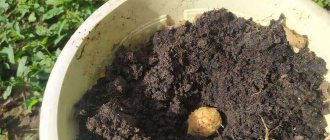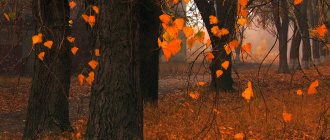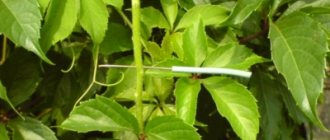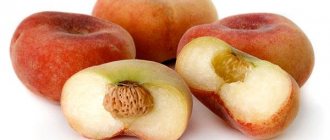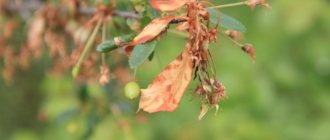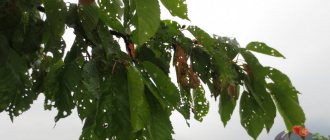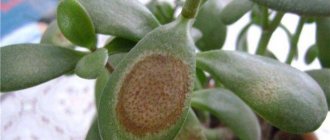Bark beetle infestation poses a great danger to an orchard. The apple tree in which the harmful larvae have settled is seriously injured. The beetle larvae gnaw through wood and sapwood, deprive the tree of juices, simultaneously infecting it with pathogenic fungi, and then mechanically destroy the trunk. An exhausted tree stops growing, loses its harvest, and if the pest is not neutralized in time, it eventually dies. Every gardener needs to know how to deal with bark beetle on apple and pear trees, and what preventive measures will help maintain a healthy garden.
Characteristics of the apple bark beetle
The bark beetle, or sapwood beetle, is an insect about 4 millimeters in size. The body of the beetle is cylindrical, dark brown in color. The elytra are covered with punctate grooves and stiff hairs. The paws and antennae are dark brown.
The bark beetle spends the main part of its life in the thickness of wood, which makes the pest difficult to detect. The emergence of insects occurs in the spring, at the end of the flowering of apple trees. At this time, the beetles mate and settle in new places, infecting fruit trees. The female bark beetle lays eggs under the bark of an apple or pear tree, gnawing holes for numerous ovipositions.
At the same time, the female bark beetle brings in the mycelium of the fungus Monilia Candida, which also begins to occupy the tree.
The eggs soon hatch into whitish larvae with powerful mandibles. They feed on the tissues and juices of the tree, leaving branched passages in the thickness of the wood. In the spring of next year, the larvae pupate, during the flowering of the apple trees they turn into mature beetles and fly out.
Diseased, weakened, shaded trees often become victims of the pest. Both adult and young plantings suffer. Pests such as bark beetles, codling moths, flower beetles and aphids can settle not only on apple and pear trees, but also on stone fruits - cherries, cherries, and plums.
Reasons for appearance
The pest is distributed quite widely - from the middle zone and south to Siberia, Transbaikalia, Yakutia, Sakhalin and Kamchatka. Therefore, it is impossible to completely insure against its occurrence. But there are several factors that provoke the invasion of bark beetles on apple trees and other trees:
- relatively warm, not too hot weather;
- cracks, cuts and other damage to the bark;
- plant remains on the site;
- lack of preventive treatments and thinning pruning.
It is important to understand that bark beetles are attracted to the smell of fresh wood. Therefore, you need to immediately remove all cut branches, as well as fallen bark, pay attention to cracks on the trunk, and, if necessary, immediately cover them with garden varnish.
Signs of defeat
The first signs of a bark beetle attack are the appearance of wood flour and sawdust on the bark of a tree or near the trunk. The sawdust is pushed out by beetles and their larvae, gnawing out the wood of the fruit tree. When examining the bark, you may notice small holes from which dust spills out.
The color of the sawdust indicates the degree of damage to the tree:
- brown and brown sawdust shows that the bark beetle is gnawing on the bast - the outer membranes of the trunk;
- white sawdust is an indicator of deep damage to the trunk by the pest.
Associated signs of damage:
- Frequent visits to trees by woodpeckers. This bird usually feeds on pests that live inside the wood.
- Sudden drying of branches, wilting, stopping of shoots in growth.
- Holes in the bark about 2 millimeters in size and gum production are obvious symptoms of bark beetle activity.
- Peeling of the bark, exposure of wood, corroded by winding passages, is the last stage, which usually ends with the death of the tree.
Experienced gardeners believe that there is no point in treating a tree heavily damaged by bark beetles - it must be immediately destroyed.
Vitalizer NV-101 - a proven pest repellent
Vitalizer NV-101 is a complex designed to combat a number of pests and diseases of fruit trees, while promoting their active growth. The drug is produced in liquid form and in the form of granules, packaged in containers of different sizes. It is based on active extracts from pine, cedar, cypress and plantain. Helps protect trees from:
- harmful bugs;
- larvae;
- caterpillars;
- bacteria and fungi.
The obvious advantage of the drug is zero toxicity. This means that you can get rid of the bark beetle without any risk of infecting trees, poisoning bees, or harming the development of microorganisms in the soil.
An additional bonus is the ability of the product to improve the resistance of trees to difficult weather conditions with an increase in the ability to bear fruit in the future.
Treatment
Before you start fighting the bark beetle, you need to carefully examine the trees in your garden. If the trunks are worn out with holes from which white sawdust is falling, the bark is separated from the wood, and there are many winding passages underneath - you will have to say goodbye to the tree: cut it down and burn it. This link will tell you what to do if mice have chewed the bark of an apple tree.
If the holes in the bark are sporadic and the wood flour is brown in color (the infection is shallow), you can still try to save the tree.
Spraying
A common practice for combating bark beetles is to spray trees after the trees have finished flowering, during the insect flight period. To carry out the procedure you must have:
- large, reliable sprayer (sprayers with a telescopic rod are convenient);
- workwear, gloves;
- a respirator to protect the respiratory tract from poisons (preferably gas-dust-proof models);
- mask or safety glasses.
The working solution of the drug is generously applied to the trunks and branches of apple, pear and other trees. Repeated treatment with insecticide is carried out after two weeks.
Remember safety precautions when processing the garden! Use medications only in the recommended dosage according to the instructions.
Insecticides
The drugs used to protect trees are systemic insecticides that can accumulate in plant tissues:
"Arrivo". The advantages of the drug are high efficiency and long-lasting action. The disadvantage is that the solution is toxic to pollinating insects and humans.
"Bitoxibacillin." Effective against adults and larvae, but does not affect eggs. The drug requires repeated treatments. Safe for bees and humans, does not accumulate in fruits.
"Calypso". The drug is fast-acting and produces a noticeable effect within a few hours. The action of the product is prolonged. Disadvantage: toxicity.
"Confidor Extra". A long-lasting product that is resistant to elevated temperatures and rinsing. Effective against pests at any stage. Low toxicity to humans and animals (hazard class III), but toxic to beneficial microorganisms (do not allow it to enter the soil). "Confidor Extra" is also used for stem injections into the tree.
"BI-58". An organophosphate preparation that acts in the intestines of the bark beetle. Low danger to humans (III hazard class). Disadvantage: the drug is toxic to bees.
Traps and repellers
A common method of garden protection is bark beetle traps and baits. In the spring, the branches cut down during pruning are laid out in piles away from the trees. The beetles are attracted by the smell of cut wood and flock to the bait to lay eggs. After the end of the beetles' summer (3-4 weeks), the branches are burned.
Mechanical collection of pests is carried out during their reproduction period - within 2-3 weeks after the apple trees bloom. Carefully inspect the trunks of apple trees and destroy any collected pests. Read here what to do if hares gnaw on an apple tree.
For private farmsteads, a more effective way to combat the bark beetle may be the use of antipheromones that repel the pest.
Antipheromone repellers are special tapes and tablets that emit an odor unpleasant to insects. They are safe for animals and humans. Antipheromone tablets are not sold in stores; they are used by specialist phytopathologists, and each type of beetle uses its own “aromatic” composition. The cost of such garden treatment is very high.
Pheromone traps cannot be used in a private garden - they will attract beetles from all over the area. They are used in large forestry enterprises to concentrate pests in a specific area and then destroy it.
Syringing
Using the injection method, you can save a tree at the beginning of beetle infestation - in the presence of brown sawdust and single flight holes, when the bark is not separated from the stem. Exterminators make injections into the tree trunk using professional devices.
Injection technique at home:
- A concentrated solution of the drug is prepared.
- The solution is poured into a volumetric syringe, then injected into the passages of the beetles.
- The holes are sealed with garden pitch.
The drugs used are Confidor, Chlorophos, Antizhuk, Karbofos, Tanrek, Calypso. The same insecticides must be sprayed on the apple tree and neighboring trees. After two weeks, the insecticide treatment is repeated.
Boosting immunity
Since the pest chooses weakened and oppressed trees, strengthening the immunity of fruit trees is an important task for the gardener in the fight against the beetle.
- Avoid unnecessary injury to the tree.
- Seal fresh cuts and tree fellings with garden varnish so as not to attract pests. This material will tell you how to cover the saw cut on an apple tree.
- Feed apple and pear trees in a timely manner. In hot and dry weather, trees must be provided with watering.
- Do not allow weeds to multiply, cultivate the soil in tree trunk circles.
The most common mistakes gardeners make
Above, we looked at how to overcome the bark beetle and what medications will help you. However, our article will not be complete without listing the most common mistakes made by summer residents, as a result of which the bark beetle attacks.
As a rule, if you have this individual in your front garden, then you probably made the following mistakes in care:
- improperly organized care;
- ignoring the manifestation of cracks in the bark and the resulting frost holes;
- in the spring after pruning the plants, the trimmed areas are not properly processed;
- lack of timely pruning;
- ignoring autumn garden cleaning.
If you do not take care of your crops and do not follow the simplest rules of care, then there is a high probability that pests will comfortably settle in your garden. The fact is that bark beetles can destroy an orchard over the summer. For this reason, try to perform the following preventive measures:
- form the crop crown correctly;
- carry out autumn treatment and remove weeds from the front garden;
- regularly carry out preventive treatments with insecticides;
- if a bark beetle has infected a tree, get rid of it immediately and burn the stumps;
- feed and water the apple trees;
- do not forget to whiten the trunks.
And lastly, if this individual has managed to colonize your garden en masse, the best option would be to seek help from the appropriate company, which will help destroy this parasite. Remember, bark beetles are capable of destroying trees in just a matter of days.
Scheme of treatment and prevention with drugs
It is recommended to use the following scheme of preventive treatment with insecticides:
1. Immediately after flowering, apple trees are sprayed with systemic preparations (Confidor, Antizhuk, Arrivo and others).
2. Repeated treatment is carried out after 2 weeks.
You can independently prepare a protective solution of laundry soap with carbolic acid . Green soap (2 cups) and the same amount of carbolic acid are dissolved in a 5-liter container. The mixture is diluted with water to a volume of 20 liters.
The resulting liquid is sprayed onto apple and pear trees.
What trees does the pest attack?
Most species living in Russia rely on coniferous trees for food: pine, spruce, thuja, juniper, larch, cedar . Some of them live only under the bark of trunks and branches, others in wood, and still others prefer to settle under the roots. There are species that damage not only wood, but also pine needles.
Some species live on deciduous and herbaceous plants. Bark beetles attack ash, rowan, hawthorn, dogwood, sloe, elm, aspen, privet, lilac, and rose hips . The bark beetle is attracted to fruit crops: apple, pear, cherry, sweet cherry, cherry plum, plum, grapes .
Some bark beetles settle on herbaceous plants, for example, on fodder clover , damaging their roots and seeds.
Preventive measures
The main measure to prevent bark beetle is to keep the orchard clean and well-groomed:
- regular inspection of fruit trees;
- timely autumn pruning;
- burning pruned branches;
- removal of plant residues and weeds in the garden.
To protect against beetles in the spring, trunks and skeletal branches are coated with lime-clay mash (a mixture of clay and manure with the addition of slaked lime). This article will tell you about whitewashing an apple tree in the spring.
During the pest's summer, beetle baits - freshly cut branches and stumps - are laid out in piles away from the trees. No later than after 3 weeks - a month, the wood trimmings must be burned. Read about pruning old apple trees here.
Senezh-Insa - a bark beetle remedy with a stable effect
An example of an excellent antiseptic is SenezhInsa, also made in Russia. The drug has been actively used since 2012 and is in demand both among professional agronomists and amateur summer residents. The product is completely colorless, packaged in small canisters of 5 liters or large barrels of 60 kg.
The concentrate is based on water, so when interacting with wood, its texture and color do not change.
The drug penetrates the tree bark, leaving the active components there. Non-toxic and effective. Helps get rid of different types of beetles and bacteria, regardless of the stages of their development.
Summarizing all of the above, we note that it is not enough to know how to cure a tree from bark beetle when insect damage has reached such a level that it is almost impossible to save the plant. In order for the garden to grow healthy and fruitful, you need to monitor the trees, preventing the appearance of pests and treating the trunks at the initial stages of infection.
conclusions
- The fight against bark beetles is quite complex and requires the use of comprehensive measures: sanitary and hygienic care of plantings, strengthening the immunity of apple and pear trees, and preventive spring treatments with systemic drugs.
- A tree that has recently been infected can still be saved by injecting the beetle burrows with insecticides. Unfortunately, trees heavily damaged by bark beetle cannot be saved - they must be destroyed by burning.
- By following preventive measures, you can prevent your garden from becoming infected. Even little things are important for this: not leaving open cuts on trees, protectively coating the trunks with a clay-lime mixture, timely removal of diseased and dried branches. Every gardener is obliged to protect his garden from the insidious invasion of bark beetles.
We help develop immunity in the culture
The best and most effective way to protect trees is to develop immunity in them. It is important to understand that a healthy crop will have strong wood, due to which the bark beetle will avoid such a crop. After all, he is looking for a tree with soft wood, in which it is easier for him to survive and lay his own offspring.
And to boost and strengthen your immune system, use tools such as:
- use the preparation nb 10, the granules of which are scattered around the tree and then watered with water;
- gum 30;
- phosphorus and potassium agents.
All these substances can strengthen the immune system of the apple crop and make it unstable to external negative factors.



